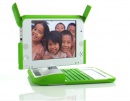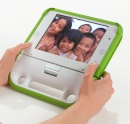Collaborative GrantProposal/TechnicalResources
The XO Laptop
Background
|
One Laptop per Child developed the XO-1 laptop as a step towards universal computer literacy. Nearly 2 million laptops are in use around the world. A few notable projects:
The laptops are low-power and durable machines, with screens which can be read in direct sunlight. The laptops have a built-in camera, connect to the internet via WiFi, and support up to 3 USB devices, a microphone, headphones, and sensors. Without wireless routers, the laptops can form their own mesh network, allowing students to collaborate on documents, painting, and maps (similar to Google Docs or Etherpad). |
|
An Open Book for Future Technology Programs
Our work will create free resources in open formats. This means that these projects can be used in future technology projects by USAID, Ugandan education officials, or other non-profit organizations.
The laptops' Sugar operating system and activities are open source technology (sugarlabs.org). This system is compatible with many systems, including new and used computers using Windows, Linux computers donated to Ugandan universities from Camara, future versions of the XO laptop, and the competing Intel Classmate laptop.
A significant portion of the health resources will be available online. These resources will be immediately available to any schools with computers and internet access. Additional funding is needed so that more students can become computer literate and gain access to these resources.
Evaluating Program through Technology
In addition to traditional monitoring through surveys and test scores, the program will be evaluated by having the technology track schools' use of these resources.
The Laptop Journal
The Journal is a custom file system which records student and teacher use of activities. A student can open the Write activity in class, start typing a paper, and save it to the Journal. Just like other file systems, the Journal stores the student's paper and keeps a note of when that application was used. The Journal also tracks whether activities were shared with other computers, and records when students use interactive learning activities such as Measure (for environmental sensing) and Moon (for phases of the moon and eclipses).
When monitoring this program, educators can visit a school, see what activities have been used by individual students, and determine how recently those activities were used.
Surveys and Polling
SugarLabs has a Poll Builder activity
This activity can open surveys from the project and use the survey to collect data. Additional programming would have the Poll activity submit results to a central project server. With or without wireless routers, the XO laptops in a classroom can connect to each other through a mesh network. The Poll activity supports this type of networking and stores results from the survey on teachers’ computers. This gives the project a backup method to collect and store survey results when internet access is temporarily unavailable at the school.
Moodle
Teachers at Kasiisi Primary School also used the education content platform Moodle, installed on a school server, to create quizzes and surveys for their students.
Tracking Resource Use by Schools
A web server can store up-to-date resources and facilitate communication between individual schools and the main project. This central server can also track participation by each school via a user-agent property.
What is a user-agent?
When a computer or mobile phone requests a page from the internet, it sends a user-agent which describes the computer's web browser and operating system. This helps the webpage display content which is compatible with the computer.
- A computer with the Windows XP operating system, using Internet Explorer 7.0
Mozilla/4.0 (compatible; MSIE 7.0; Windows NT 5.1; .NET CLR 1.1.4322; .NET CLR 2.0.50727; InfoPath.1; .NET CLR 3.0.4506.2152; .NET CLR 3.5.30729),gzip(gfe)
- An OLPC XO laptop with the Linux operating system, using the Browse activity (a simplified version of Mozilla Firefox)
Mozilla/5.0 (X11; U; Linux i586; en-US; rv:1.9) Gecko/2008072400 OLPC/0.4.6-1.olpc3 (XO) Firefox/3.0,gzip(gfe)
How will this be applied to schools?
The laptops will be customized with a school-specific ID in the user-agent. There will be no effect on internet accessibility.
Our health resources program website will be hosted on a server which tracks use of each health resource, and the participation of each school in the program. Additional partnerships can be made with health, literacy, and primary education projects (such as Uganda's Newspapers in Education program) to track schools' participation in online activities.
Activities and Curriculum
The XO laptop and other computers running Sugar have access to a library of free and open source applications from http://wiki.laptop.org and http://activities.sugarlabs.org
Health Resources
Straight Talk
Straight Talk is a simple but honest and myth-dispelling newsletter focused on health and other problems faced by adolescent students http://www.scribd.com/Straight%20Talk%20Foundation
Research finds that Straight Talk meets several needs of good health content, but needs additional support and context from teachers and mentors. http://www.socialscience.nl/application/upload/files/ASS%201(1)%20Ferris.pdf
UNESCO Children's Health Booklets
Short stories for children, focusing on specific health topics. Many of the books are written by administrators and educators in Africa: http://wiki.laptop.org/go/Childrens_Health_Books
HIV/AIDS Alliance
The International HIV/AIDS Alliance has posted digital health resources and personal stories which can be published on the XO laptops. Additional resources and future blog posts can be linked from the main project website
Information and Communication Technology Centers for Health Awareness
The laptops can contain directories of ICT centers which cater to health awareness, especially HIV/AIDS awareness and information
OLPC Canada
OLPC Canada has developed activities for healthy decision-making:
- The Meeting Place: scenarios and topics about physical and mental health, including smoking, alcohol, and other drugs
- Swift Feet: - exercise and physical fitness activity
- Healthy Heart: information on a healthy diet
Online Resources
Online resources can provide additional information and up-to-date warnings in health crises such as the 2010 smallpox scare in eastern Uganda.
Interactive Health Education
Health education is a major priority of the Kasiisi Project. Each school had informative posters about prevention and risks of HIV/AIDS, and also acceptance of people living with the disease. Students paint murals and messages on school walls to encourage good health. The Kasiisi Project also partners with teachers from the United States. Several visited and educated students at each primary school about their health, wellbeing, and responsibilities as young men and women.
Fewer students have access to interactive health education such as Girl Guides, the Kasiisi Project’s Girls Support Program, and peer educator training. It is crucial for students to have mentors and discussions so that students of all learning types understand health lessons and find answers to their questions. Asking questions anonymously is a tactic used in the US to make it possible for students to ask questions which they would be embarrassed to ask publicly. Online health resources make it possible for students to ask anonymous questions and for common questions to become part of the curriculum. Straight Talk and the newspapers for schools program run by the Daily Monitor are used to give students information, but without interactivity it is difficult to measure how many students read the material, what they learn from it, and what questions remain unanswered.
Problem-Solving
As students get deeper into their math lessons, it starts to become more abstract. Old-fashioned education methods can discourage students from finding applications of math, and instead teaches memorization. Students are curious about computers and their workings, and are drawn to find ways to use them for their own projects. The laptop has several projects designed to teach programming through constructionist use of mathematics and problem-solving. With the laptops, students can peek into the inner workings of simple programs such as Camera.py, or discover art made by drag-and-drop blocks in TurtleArt / Logo.
Working with interactive programs such as Scratch have been used for students to make presentations to extend and present their coursework: http://www.youtube.com/watch?v=B73_YdwMM7Y
For younger students, the laptops contain games such as Tangrams and Towers of Hanoi which are fun and encourage spatial reasoning.
WikiPack
A WikiPack content pack can be added to add English and Simple English articles and photos to the existing WikiBrowse activity.
Selected articles would be relevant to health, Ugandan history, world history, and science classes.
Algebra and Geometry
Advanced math skills can be taught using early programming skills applications such as TurtleArt
Geography
Map and Geoquiz activities can prepare students for exams in geography. The Conozco Uruguay activity could be modified to teach features in Ugandan geography such as names of major cities, lakes, and mountains.
Science and Sensing
The Measure activity can read realtime values of sensors, with weather, solar, heart rate and environmental health factors.
Existing Projects
- Students use temperature, light, rotation, and RFID sensors in Kasiisi School laptop program
- A heart rate monitor from OLPC Goldenstate: http://blog.laptop.org/2009/04/08/low-cost-heart-rate-monitor/
- Work is ongoing on sensors for water quality, pulse oximetry, and volatile organic compunds (such as carbon monoxide gas)
Spreadsheets and Graphing
The laptops have three main graphing activiites: Measure, SocialCalc, and Finance.



